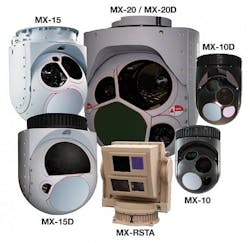Air Force orders electro-optical sensors for airborne surveillance from L-3 Sonoma
WRIGHT-PATTERSON AFB, Ohio – U.S. Air Force airborne surveillance experts needed visible-light and infrared electro-opticalsensors for helicopters and fixed-wing aircraft. They found their solution from L-3 Communications.
Officials of the Air Force Life Cycle Management Center at Wright-Patterson Air Force Base, Ohio, announced a contract worth as much as $90 million earlier this month to the L-3 Sonoma EO segment in Santa Rosa, Calif., to provide MX series electro-optical and infrared sensors turrets and features.
L-3 Sonoma will provide the company's MX-series airborne imaging and targeting systems with overlapping fields-of-view, common electronics and cabling, common user interfaces and video overlays, and common software and internal components.
The MX-series is for fixed-wing aircraft, helicopters, unmanned aerial vehicles (UAVs, and aerostats for uninterrupted surveillance of borders, forward operating bases, airfields, and other enemy assets.
The MX-series consists of the MX-8, MX-19, MX-15, MX-20, and MX-25. The MX-8 is for small fixed-wing aircraft and helicopters, UAVs, and tactical aerostats. It weighs 15 pounds and supports as many as four electro-optical sensors simultaneously.
Related: Army chooses airborne electro-optical sensor payloads for reconnaissance from L-3 Wescam
The MX-10 is for low-altitude tactical surveillance and search and rescue missions. It weighs 37 pounds and supports as many as six sensors simultaneously, including an HD camera. The MX-15 is for medium-altitude covert intelligence, surveillance & reconnaissance, It weighs 50 pounds and supports as many as six sensors, including HF visible-light and infrared cameras.
The MX-20 is for high-altitude long-range maritime patrol aircraft and persistent surveillance missions. It supports as many as seven sensors simultaneously, including HD visible-light and electro-optical cameras, as well as three laser illuminators. The MX-25, meanwhile, is for high-altitude, long-endurance intelligence, surveillance and reconnaissance missions, and supports as many as six sensors simultaneously, including long-range target Illumination, pointing, and range-finding with high-performance haze penetration.
On this contract L-3 will do the work in Burlington, Ontario, and should be finished by December 2022. The contract has an option that could extend it through December 2027.
For more information contact L-3 Sonoma EO online at www2.l3t.com/sonomaeo/index.htm, or the Air Force Life Cycle Management Center at www.wpafb.af.mil/aflcmc.
Ready to make a purchase? Search the Military & Aerospace Electronics Buyer's Guide for companies, new products, press releases, and videos

